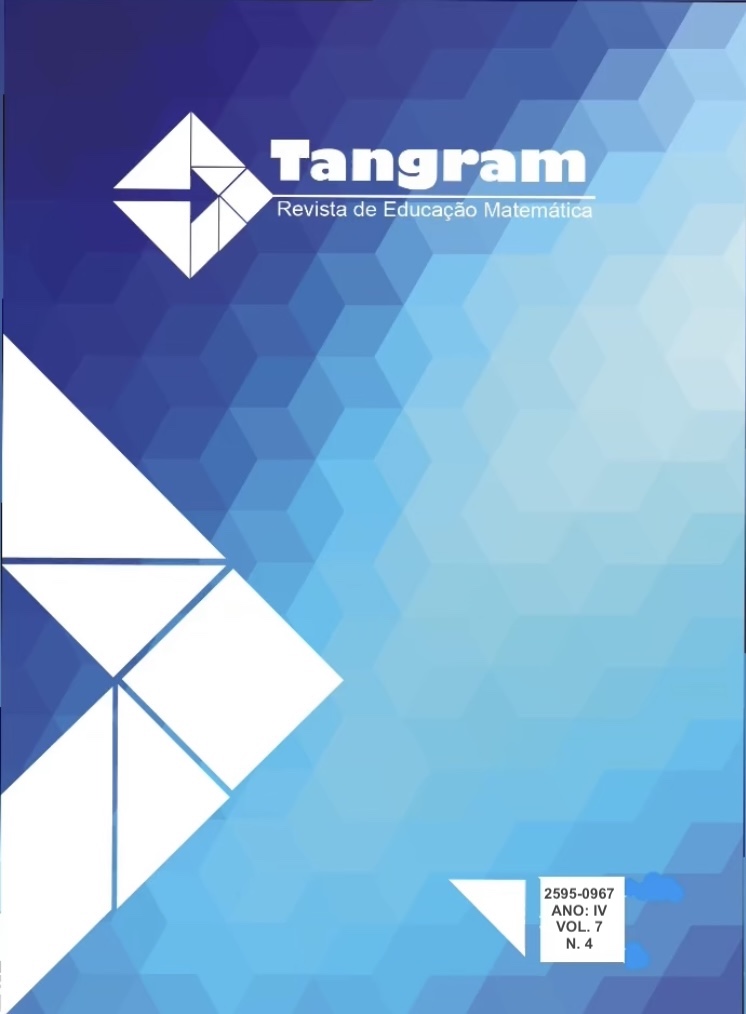O uso de uma receita de bolo para ensinar algoritmo e fluxograma
DOI:
https://doi.org/10.30612/tangram.v7i4.18158Keywords:
Ensino de Matemática, Cotidiano, Sem mais nem menos, Covid-19Abstract
In this article, we will present one of the activities developed and applied by the extension project “No more nor less”, from the Mathematics Institute of the Federal University of Alagoas, highlighting its results in online and in-person applications. The activity is titled “Algorithm and flowchart: the mathematics present in the cake recipe” and addresses the mathematical concepts of algorithm and flowchart through the recipe for a chocolate cake. Its main objective was to show the concept of an algorithm related to everyday mathematics. In the online format, the activity was carried out via a live broadcast on the project's Instagram and, upon returning to the classroom, it was carried out in a school in the state of Alagoas. At the end of the applications, the importance of the activity and project was highlighted, as it provided more meaningful learning for students, pedagogical gains for teachers and brought the University closer to the society involved.
Downloads
References
Barros, J. de. S, & Ribeiro, V. B. (2022). Ensino remoto emergencial. Pedagogia em Ação, 18(1), 68-80. Recuperado de https://periodicos.pucminas.br/index.php/pedagogiacao/article/view/28829.
Boaler, J., Munson, J., & Williams, C. (2018). Mentalidades matemáticas na sala de aula: ensino fundamental. Porto Alegre: Penso.
Bombana, C. G. G., & Teixeira, A. C. (2020). As metodologias ativas e o sistema atencional: um estado do conhecimento. Teoria e Prática da Educação, 23(1), 73-88. Recuperado de https://doi.org/10.4025/tpe.v23i1.48582 DOI: https://doi.org/10.4025/tpe.v23i1.48582
Brasil. (2018). Ministério da Educação. Base Nacional Comum Curricular: educação é a base. Brasília: MEC/Consed/Undime. Recuperado de http://basenacionalcomum.mec.gov.br/ .
Brasil. (1998). Ministério da Educação. Secretaria de Educação Fundamental. Parâmetros Curriculares Nacionais: Matemática. MEC: Brasília.
Ferrari, F., & Cechinel, C. (2008). Introdução a algoritmos e programação. Bagé: Universidade Federal do Pampa. Recuperado de https://lief.if.ufrgs.br/pub/linguagens/FFerrari-CCechinel-Introducao-a-algoritmos.pdf.
Gusmão, A. S., Gaudêncio, A. C. F., Silva, A. B. da. S. Jr., & Gaudêncio, R. N. F. (2024). Desafios e Impactos: uma revisão bibliográfica sobre o atraso na aprendizagem causado pela pandemia. Revista Gênero e Interdisciplinaridade, 5 (03), 100–116. Recuperado de https://doi.org/10.51249/gei.v5i03.2062. DOI: https://doi.org/10.51249/gei.v5i03.2062
Kato, D. S., & Kawasaki, C. S. (2011). As concepções de contextualização do ensino em documentos curriculares oficiais e de professores de ciências. Ciência & Educação (Bauru) [online]. 2011, v. 17, n. 1, pp. 35-50. Recuperado de https://doi.org/10.1590/S1516-73132011000100003. DOI: https://doi.org/10.1590/S1516-73132011000100003
Monteiro, A., & Pompeu, G. J., Jr. (2003). A Matemática e os Temas Transversais. São Paulo. Ed. Moderna Ltda.
Moreira, M. A. (2022). Aprendizagem ativa com significado. Revista Espaço Pedagógico, 29(2), 405-416. Recuperado de https://seer.upf.br/index.php/rep/article/view/13887. DOI: https://doi.org/10.5335/rep.v29i2.13887
Rocha, S. M. G. da, & Oliveira, I. B. de., Jr. (2016). O erro e seu papel na avaliação da aprendizagem: breves reflexões. Gov.br website. Recuperado de http://www.diaadiaeducacao.pr.gov.br/portals/cadernospde/pdebusca/producoes_pde/2016/2016_artigo_ped_unespar-apucarana_soniamartinsgoncalves.
Santos, A. da. S., Albuquerque, E. da. C., & Santos, V. de O. (2021, novembro). Sem mais nem menos online: “Algoritmo e fluxograma: a matemática presente na receita do bolo”. Anais do 2º Simpósio da Formação do Professor de Matemática da região Centro-Oeste, Campo Grande, MS, Brasil.
Santos, V. de O., Albuquerque, E. da. C., Santos, K.T. R. dos., & Oliveira, W. C. (2021). Lives no Instagram envolvendo matemática no dia a dia: contribuições do projeto “Sem mais nem menos on-line” para estudantes e professores da Educação Básica. Revista Professor de Matemática Online, 9(1), 57-75. Recuperado de https://pmo.sbm.org.br/wp-content/uploads/sites/5/sites/5/2021/10/art4_PMO_Chamada_Tematica_SBM_FLUXO2021.pdf. DOI: https://doi.org/10.21711/2319023x2021/pmo94
Schwanz, C. B., & Felcher, C. D. O. (2020). Reflexões acerca dos desafios da aprendizagem matemática no ensino remoto. Redin - Revista Educacional Interdisciplinar, 9(1), 91-106. Recuperado de https://seer.faccat.br/index.php/redin/article/view/1868.
Silva, A. F. U da. (2020). Fluxogramas: uma nova linguagem para trabalhar divisibilidade no Ensino Básico (Dissertação de mestrado). Universidade Estadual Paulista Júlio de Mesquita, Rio Claro, SP, Brasil. Recuperado de https://repositorio.unesp.br/handle/11449/202257
Teixeira, C. D. J., Fraz, J. N., Ferreira, W. C., & Moreira, G. E. (2021).
Percepção de professores que ensinam matemática sobre o ensino remoto emergencial e o processo de ensino-aprendizagem. Debates em educação, 13(31), 966-991. Recuperado de https://www.seer.ufal.br/index.php/debateseducacao/article/view/11784. DOI: https://doi.org/10.28998/2175-6600.2021v13n31p966-991
Downloads
Published
How to Cite
Issue
Section
License
Copyright (c) 2024 TANGRAM - Revista de Educação Matemática

This work is licensed under a Creative Commons Attribution-NonCommercial-ShareAlike 3.0 Unported License.
Authors must accept the publication rules when submitting the journal, as well as agree to the following terms:
(a) The Editorial Board reserves the right to make changes to the Portuguese language in the originals to maintain the cultured standard of the language, while respecting the style of the authors.
(b) Authors retain the copyright and grant the journal the right to first publication, with the work simultaneously licensed under the Attribution-NonCommercial-ShareAlike 3.0 Brazil (CC BY-NC-SA 3.0 BR) that allows: Share - copy and redistribute the material in any medium or format and Adapt - remix, transform, and create from the material. CC BY-NC-SA 3.0 BR considers the following terms:
- Attribution - You must give the appropriate credit, provide a link to the license and indicate whether changes have been made. You must do so under any reasonable circumstances, but in no way that would suggest that the licensor supports you or your use.
- NonCommercial - You may not use the material for commercial purposes.
- Sharing - If you remix, transform, or create from material, you must distribute your contributions under the same license as the original.
- No additional restrictions - You may not apply legal terms or technological measures that legally restrict others from doing anything that the license permits.
(c) After publication, authors are allowed and encouraged to publish and distribute their work online - in institutional repositories, personal page, social network or other scientific dissemination sites, as long as the publication is not for commercial purposes.






